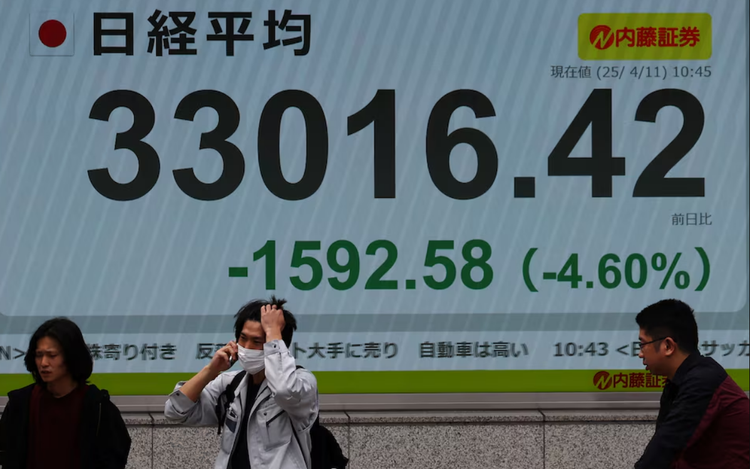
People walk past an electronic screen displaying Japan's Nikkei share average outside a brokerage in Tokyo, Japan, April 11, 2025. Photo: Reuters
The anxiety has sparked a rush into safe havens, sending the Swiss franc soaring to a decade high against the dollar, and gold to a new peak after a brief but massive relief rally following U.S. President Donald Trump's move to temporarily lower tariffs on many countries.
The selloff in U.S. Treasuries picked up pace during Asian hours, with the 10-year note yield rising to 4.475%, gaining over 40 basis points in the week, the biggest increase since 2001, LSEG data showed.
Analysts and investors across the globe have pointed to this week's sharp sell-off in Treasuries and weakness in the dollar as evidence that confidence in the world's biggest economy has been shaken.
"There's clearly an exodus from U.S. assets. A falling currency and bond market is never a good sign," said Kyle Rodda, senior financial markets analyst at Capital.com. "This goes beyond pricing in a growth slowdown and trade uncertainty."
In Asia, Japan's Nikkei tumbled 4.5% on the day, while stocks in South Korea fell 1.7%. MSCI's broadest index of Asia-Pacific shares outside Japan was 0.5% lower.
U.S. futures for S&P 500 and Nasdaq fell about 1% each after a sharp drop overnight.
"The short-term outlook for global risk assets remains uncertain given growth and inflation concerns, fluid sentiments and fast-changing developments on the trade and tariff fronts," said Vasu Menon, managing director of investment strategy at OCBC Bank in Singapore.
Investors are grappling with worries over the escalating Sino-U.S. trade war after Trump ratcheted up tariffs on Chinese imports, raising them effectively to 145%.
China has hit back, hiking its tariffs on the U.S. with each Trump increase, raising fears that Beijing may jack up duties above the current 84%.
Chinese stocks made a subdued start on Friday. The blue-chip CSI300 Index was off 0.5% while Hong Kong's benchmark Hang Seng was down 0.38%.
James Athey, fixed income manager at Marlborough, said the outlook remains darker and more clouded in uncertainty than it did a month ago. "There are still so many unanswered and unanswerable questions."
Dollar Loses Its Crown
The U.S. dollar has faced relentless selling in the past few weeks, with traders seeking shelter in the Japanese yen, the Swiss franc as well as the euro .
On Friday, the dollar sank to its lowest in 10 years against the Swiss franc and a six-month low against the yen. The euro surged 1.7% to $1.13855, a level last seen in February 2022.
The dollar index, which measures the greenback against six other units, fell below 100 for the first time since July 2023. The dollar's slide provided relief to some of the currencies in emerging markets, including the ringgit.
Markets mostly shrugged off data from U.S. Labor Department that showed consumer prices unexpectedly fell in March although the improvement in inflation is unlikely to be sustained in the wake of tariffs.
Meanwhile, a violent U.S. Treasury selloff this week, evoking the COVID-era "dash for cash", had reignited fears of fragility in the world's biggest bond market.
Thirty-year bond yields rose to 4.90%, on course for their biggest weekly jump since at least 1982, LSEG data showed.
In commodities, gold prices scaled a record high on safe haven flows. It was last up 1.25% at $3,214 per ounce.
Oil prices slipped in early trading on Friday after settling more than $2 per barrel lower on Thursday. U.S. West Texas Intermediate crude futures fell 0.48%, while Brent crude futures fell 0.46%.


Max: 1500 characters
There are no comments yet. Be the first to comment.